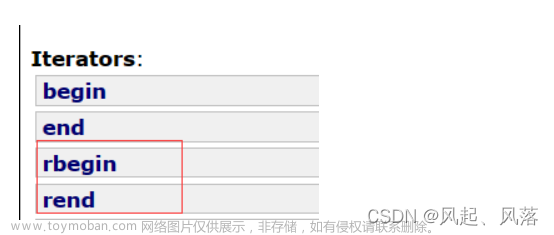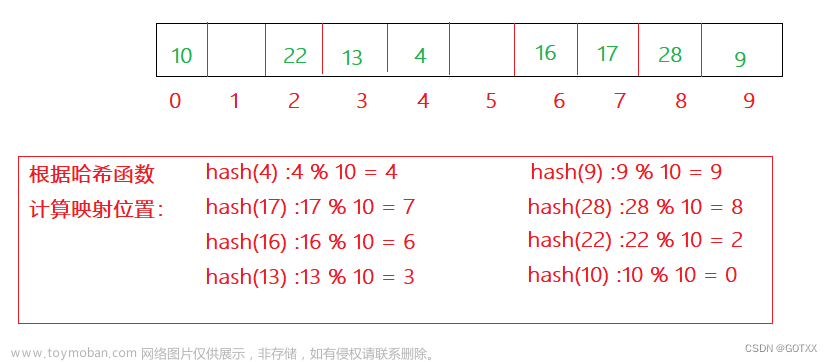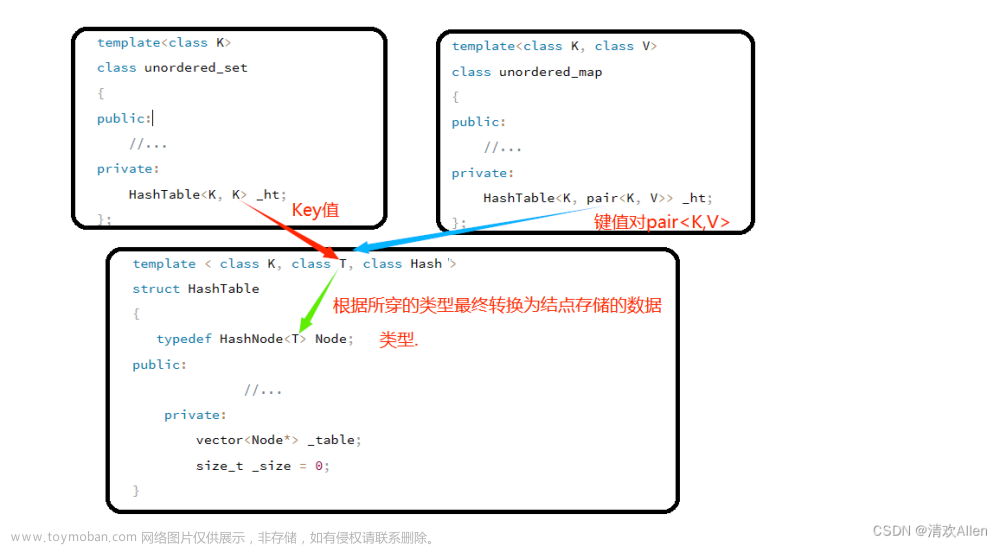注:实现unordered系列容器是为了学习,因此并非将全部接口实现,所以只实现部分接口
目录
哈希表的改造
模板参数列表的改造
增加迭代器操作
增加通过T获取value操作
HashTable.h的修改
unordered_set的封装
unordered_map的封装
哈希表的改造
模板参数列表的改造
- K:关键码类型
- T:不同容器T的类型不同,如果是unordered_map,T代表一个键值对;如果是unordered_set,V为K
- KeyOfT:因为V的类型不同,通过T取key的方式就不同
- HashFunc:哈希函数仿函数对象类型,哈希函数使用除留余数法,需要将Key转换为整形数字才能取模
template<class K, class T, class KeyOfT, class HashFunc = DefaultfHash<T>>
class HashTable;增加迭代器操作
//声明节点类,否则迭代器无法识别
template<class T>
struct HashNode;
//声明哈希表结构,否则迭代器无法识别
template<class K, class T, class KeyOfT, class HashFunc>
struct HashTable;
//迭代器实现
template<class K, class T, class KeyOfT, class HashFunc>
class __HTIterator
{
typedef HashNode<T> Node;//节点
typedef __HTIterator<K, T, KeyOfT, HashFunc> iterator;//返回迭代器
public:
Node* _node;
HashTable<K, T, KeyOfT, HashFunc>* _pht;//跳向下一个桶需要
//构造函数
__HTIterator()
{}
__HTIterator(Node* node, HashTable<K, T, KeyOfT, HashFunc>* pht)
:_node(node)
, _pht(pht)
{}
iterator& operator++()
{
//分别处理同一个桶中迭代和跳向下一个桶迭代
if (_node->_next)
{
_node = _node->_next;
}
else
{
size_t hashi = HashFunc()(KeyOfT()(_node->_data)) % _pht->_table.size();
++hashi;
for (; hashi < _pht->_table.size(); ++hashi)
{
if (_pht->_table[hashi])
{
_node = _pht->_table[hashi];
break;
}
}
//走到末尾
if (hashi == _pht->_table.size())
_node = nullptr;
}
return *this;
}
//返回数据
T& operator*()
{
return _node->_data;
}
//返回数据的地址
T* operator->()
{
return &_node->_data;
}
bool operator==(const iterator& it) const
{
return _node == it._node;
}
bool operator!=(const iterator& it) const
{
return _node != it._node;
}
};增加通过T获取value操作
//K针对find和erase需要使用
//T是针对上层unordered_set传入的是K而unordered_map传入的是pair<K, V>做出更高维度泛型的处理
//KeyOfT是提取出vaule中的unordered_set和unordered_map中的K
//HashFunc哈希函数
template<class K, class T, class KeyOfT, class HashFunc>
struct HashTable
{
typedef HashNode<T> Node;
//迭代器实现中需要访问哈希表中的私有成员
template<class K, class T, class KeyOfT, class HashFunc>
friend class __HTIterator;
public:
typedef __HTIterator<K, T, KeyOfT, HashFunc> iterator;
//析构函数需要自己实现,vector存的是内置类型,不会释放节点,只会释放表
~HashTable()
{
for (int i = 0; i < _table.size(); ++i)
{
Node* cur = _table[i];
while (cur)
{
Node* next = cur->_next;
if (cur)
delete cur;
cur = next;
}
_table[i] = nullptr;
}
}
//需要寻找第一个存储数据的位置
iterator begin()
{
for (int i = 0; i < _table.size(); ++i)
{
Node* cur = _table[i];
while (cur)
if (cur)
return iterator(cur, this);
}
return iterator(nullptr, this);
}
//末尾为nullptr
iterator end()
{
return iterator(nullptr, this);
}
pair<iterator, bool> Insert(const T& data)
{
//不存入key值相同数据
iterator pos = Find(KeyOfT()(data));
if (pos != end())
return make_pair(pos, false);
//负载因子大小和表的大小一样大的时候扩容
if (_table.size() == _n)
{
size_t newsize = _table.size() == 0 ? 10 : _table.size() * 2;
vector<Node*> newtable;
newtable.resize(newsize, nullptr);
//遍历旧表,将旧表中的节点插入到新表中
for (int i = 0; i < _table.size(); ++i)
{
Node* cur = _table[i];
while (cur)
{
Node* next = cur->_next;//存储next方便更新cur
//寻找该节点在新表中的位置
size_t hashi = HashFunc()(KeyOfT()(cur->_data)) % newsize;
//单链表的头插
cur->_next = newtable[hashi];//将待插入节点的next指向待插入位置的第一个节点
newtable[hashi] = cur;//将待插入节点插入到待插入位置
cur = next;//更新cur
}
_table[i] = nullptr;//将旧表位置置空
}
_table.swap(newtable);//将处理好的数据交换给旧表
}
//经过上面处理后将数据存入
size_t hashi = HashFunc()(KeyOfT()(data));
hashi %= _table.size();
//将节点头插到链表中
Node* newnode = new Node(data);
newnode->_next = _table[hashi];
_table[hashi] = newnode;
++_n;
return make_pair(iterator(newnode, this), true);
}
iterator Find(const K& key)
{
//表空无法查找
if (_table.size() == 0)
return iterator(nullptr, this);
size_t hashi = HashFunc()(key);
hashi %= _table.size();
//从计算到位置处开始查询该处链表中是否存在该key
Node* cur = _table[hashi];
while (cur)
{
if (KeyOfT()(cur->_data) == key)
return iterator(cur, this);
cur = cur->_next;
}
return iterator(nullptr, this);
}
bool Erase(const K& key)
{
//表为空无法删除
if (_table.size() == 0)
return false;
size_t hashi = HashFunc()(key);
hashi %= _table.size();
//找到对应位置后进行单链表的删除
Node* cur = _table[hashi];
Node* prev = nullptr;
while (cur)
{
//单链表的头删和普通删除
if (KeyOfT()(cur->_data) == key)
{
if (prev == nullptr)
_table[hashi] = cur->_next;
else
prev->_next = cur->_next;
delete cur;
return true;
}
prev = cur;
cur = cur->_next;
}
return false;
}
private:
vector<Node*> _table;//每个位置存储链表
size_t _n = 0;//负载因子
};以上是对哈希表的改造,将以上的实现和修改放在一起
HashTable.h的修改
#pragma once
#include <vector>
using namespace std;
//哈希函数
template<class K>
struct DefaultHash
{
size_t operator()(const K& key)
{
return (size_t)key;
}
};
template<>
struct DefaultHash<string>
{
size_t operator()(const string& key)
{
size_t hashi = 0;
for (auto& ch : key)
hashi = hashi * 131 + ch;
return hashi;
}
};
namespace Bucket
{
//声明节点类,否则迭代器无法识别
template<class T>
struct HashNode;
//声明哈希表结构,否则迭代器无法识别
template<class K, class T, class KeyOfT, class HashFunc>
struct HashTable;
//迭代器实现
template<class K, class T, class KeyOfT, class HashFunc>
class __HTIterator
{
typedef HashNode<T> Node;
typedef __HTIterator<K, T, KeyOfT, HashFunc> iterator;
public:
Node* _node;
HashTable<K, T, KeyOfT, HashFunc>* _pht;//跳向下一个桶需要
__HTIterator()
{}
__HTIterator(Node* node, HashTable<K, T, KeyOfT, HashFunc>* pht)
:_node(node)
, _pht(pht)
{}
iterator& operator++()
{
//分别处理同一个桶中迭代和跳向下一个桶迭代
if (_node->_next)
{
_node = _node->_next;
}
else
{
size_t hashi = HashFunc()(KeyOfT()(_node->_data)) % _pht->_table.size();
++hashi;
for (; hashi < _pht->_table.size(); ++hashi)
{
if (_pht->_table[hashi])
{
_node = _pht->_table[hashi];
break;
}
}
//走到末尾
if (hashi == _pht->_table.size())
_node = nullptr;
}
return *this;
}
T& operator*()
{
return _node->_data;
}
T* operator->()
{
return &_node->_data;
}
bool operator==(const iterator& it) const
{
return _node == it._node;
}
bool operator!=(const iterator& it) const
{
return _node != it._node;
}
};
//节点的实现
template<class T>
struct HashNode
{
T _data;
HashNode<T>* _next;
HashNode(const T& data)
:_data(data)
, _next(nullptr)
{}
};
//K针对find和erase需要使用
//T是针对上层unordered_set传入的是K而unordered_map传入的是pair<K, V>做出更高维度泛型的处理
//KeyOfT是提取出vaule中的unordered_set和unordered_map中的K
//HashFunc哈希函数
template<class K, class T, class KeyOfT, class HashFunc>
struct HashTable
{
typedef HashNode<T> Node;
//迭代器实现中需要访问哈希表中的私有成员
template<class K, class T, class KeyOfT, class HashFunc>
friend class __HTIterator;
public:
typedef __HTIterator<K, T, KeyOfT, HashFunc> iterator;
//析构函数需要自己实现,vector存的是内置类型,不会释放节点,只会释放表
~HashTable()
{
for (int i = 0; i < _table.size(); ++i)
{
Node* cur = _table[i];
while (cur)
{
Node* next = cur->_next;
if (cur)
delete cur;
cur = next;
}
_table[i] = nullptr;
}
}
//需要寻找第一个存储数据的位置
iterator begin()
{
for (int i = 0; i < _table.size(); ++i)
{
Node* cur = _table[i];
while (cur)
if (cur)
return iterator(cur, this);
}
return iterator(nullptr, this);
}
//末尾为nullptr
iterator end()
{
return iterator(nullptr, this);
}
pair<iterator, bool> Insert(const T& data)
{
//不存入key值相同数据
iterator pos = Find(KeyOfT()(data));
if (pos != end())
return make_pair(pos, false);
//负载因子大小和表的大小一样大的时候扩容
if (_table.size() == _n)
{
size_t newsize = _table.size() == 0 ? 10 : _table.size() * 2;
vector<Node*> newtable;
newtable.resize(newsize, nullptr);
//遍历旧表,将旧表中的节点插入到新表中
for (int i = 0; i < _table.size(); ++i)
{
Node* cur = _table[i];
while (cur)
{
Node* next = cur->_next;//存储next方便更新cur
//寻找该节点在新表中的位置
size_t hashi = HashFunc()(KeyOfT()(cur->_data)) % newsize;
//单链表的头插
cur->_next = newtable[hashi];//将待插入节点的next指向待插入位置的第一个节点
newtable[hashi] = cur;//将待插入节点插入到待插入位置
cur = next;//更新cur
}
_table[i] = nullptr;//将旧表位置置空
}
_table.swap(newtable);//将处理好的数据交换给旧表
}
//经过上面处理后将数据存入
size_t hashi = HashFunc()(KeyOfT()(data));
hashi %= _table.size();
//将节点头插到链表中
Node* newnode = new Node(data);
newnode->_next = _table[hashi];
_table[hashi] = newnode;
++_n;
return make_pair(iterator(newnode, this), true);
}
iterator Find(const K& key)
{
//表空无法查找
if (_table.size() == 0)
return iterator(nullptr, this);
size_t hashi = HashFunc()(key);
hashi %= _table.size();
//从计算到位置处开始查询该处链表中是否存在该key
Node* cur = _table[hashi];
while (cur)
{
if (KeyOfT()(cur->_data) == key)
return iterator(cur, this);
cur = cur->_next;
}
return iterator(nullptr, this);
}
bool Erase(const K& key)
{
//表为空无法删除
if (_table.size() == 0)
return false;
size_t hashi = HashFunc()(key);
hashi %= _table.size();
//找到对应位置后进行单链表的删除
Node* cur = _table[hashi];
Node* prev = nullptr;
while (cur)
{
//单链表的头删和普通删除
if (KeyOfT()(cur->_data) == key)
{
if (prev == nullptr)
_table[hashi] = cur->_next;
else
prev->_next = cur->_next;
delete cur;
return true;
}
prev = cur;
cur = cur->_next;
}
return false;
}
private:
vector<Node*> _table;//每个位置存储链表
size_t _n = 0;//负载因子
};
}值得一提的是对于扩容,为了提高效率有将容量扩至素数这种说法,但是并没有很好的理论支持,stl3.0源码SGI版本的有采用这种方式,但是由于并没有很好的理论的支持,这里不做处理
unordered_set的封装
#pragma once
#include "HashTable.h"
namespace mystl
{
template<class K, class HashFunc = DefaultHash<K>>
struct Unordered_Set
{
//提供K
struct SetKeyOfT
{
const K& operator()(const K& key)
{
return key;
}
};
public:
typedef typename Bucket::HashTable<K, K, SetKeyOfT, HashFunc>::iterator iterator;
iterator begin()
{
return _ht.begin();
}
iterator end()
{
return _ht.end();
}
pair<iterator, bool> insert(const K& key)
{
return _ht.Insert(key);
}
iterator find(const K& key)
{
return _ht.Find(key);
}
bool erase(const K& key)
{
return _ht.Erase(key);
}
private:
Bucket::HashTable<K, K, SetKeyOfT, HashFunc> _ht;
};
}全是调用的HashTable的函数,没有什么很复杂的实现文章来源:https://www.toymoban.com/news/detail-446881.html
unordered_map的封装
#pragma once
#include "HashTable.h"
namespace mystl
{
template<class K, class V, class HashFunc = DefaultHash<K>>
struct Unordered_Map
{
//提供K
struct MapKeyOfT
{
const K& operator()(const pair<K, V>& kv)
{
return kv.first;
}
};
public:
typedef typename Bucket::HashTable<K, pair<K, V>, MapKeyOfT, HashFunc>::iterator iterator;
iterator begin()
{
return _ht.begin();
}
iterator end()
{
return _ht.end();
}
pair<iterator, bool> Insert(const pair<K, V>& kv)
{
return _ht.Insert(kv);
}
iterator Find(const K& key)
{
return _ht.Find(key);
}
bool Erase(const K& key)
{
return _ht.Erase(key);
}
//实现operator[]
V& operator[](const K& key)
{
//调用insert,不存在插入key,否则不插入key
pair<iterator, bool> ret = _ht.Insert(make_pair(key, V()));
return ret.first->second;//调用operator->取数据中的value
}
private:
Bucket::HashTable<K, pair<K, V>, MapKeyOfT, HashFunc> _ht;
};
}同上,封装HashTable的函数即可,需要注意的是unordered_map重载了operator[]而operator[]的底层是调用了哈希表的insert来做处理的文章来源地址https://www.toymoban.com/news/detail-446881.html
到了这里,关于封装unordered_set&&unordered_map的文章就介绍完了。如果您还想了解更多内容,请在右上角搜索TOY模板网以前的文章或继续浏览下面的相关文章,希望大家以后多多支持TOY模板网!














